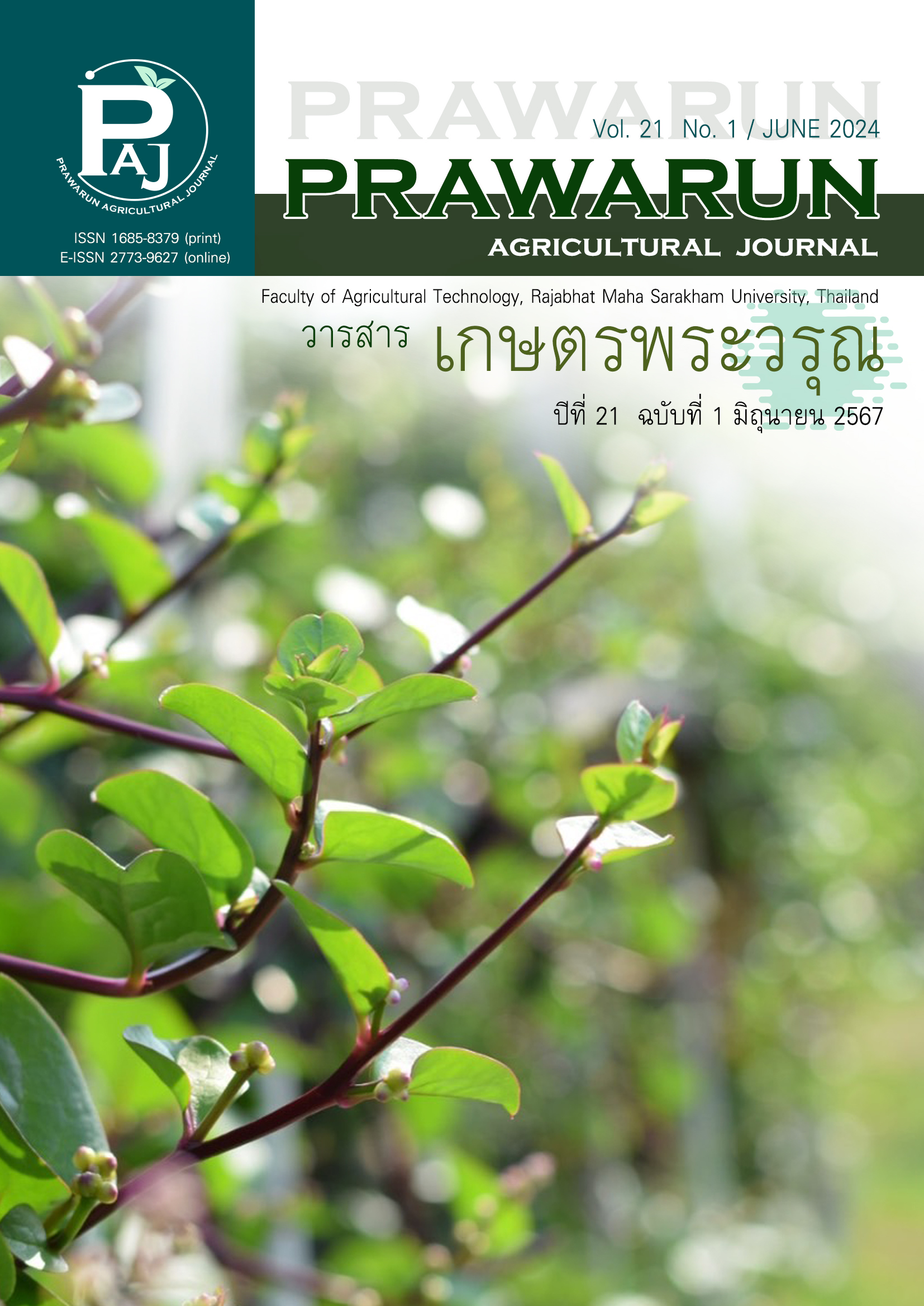การจัดการแปลงปลูกด้วยวัสดุอินทรีย์ที่มีผลต่อคุณภาพและองค์ประกอบทางเคมีของเมล็ดพันธุ์ถั่วเหลืองเชียงใหม่ 60
Main Article Content
บทคัดย่อ
การจัดการแปลงปลูกพืชด้วยวัสดุอินทรีย์ที่เหมาะสมนับเป็นหนึ่งในการทำการเกษตรยั่งยืนตามเป้าหมายการพัฒนาที่ยั่งยืน (GDSs) เพื่อลดผลกระทบต่อสุขภาพและสิ่งแวดล้อม และเพิ่มประสิทธิภาพในการทำการเกษตรของประเทศไทย การศึกษาครั้งนี้มีวัตถุประสงค์เพื่อศึกษาผลของวัสดุอินทรีย์ชนิดต่าง ๆ ในแปลงปลูก ที่มีผลต่อคุณภาพและองค์ประกอบทางเคมีของเมล็ดถั่วเหลืองพันธุ์เชียงใหม่ 60 วางแผนการทดลองแบบ completely randomized design แบ่งออกเป็น 9 กรรมวิธี ได้แก่ 1) ไม่ใส่วัสดุอินทรีย์ (ชุดควบคุม) 2) ใส่ปุ๋ยเคมีตามวิธีของเกษตรกร 3) ใส่ฟางข้าว 4) ใส่มูลวัว 5) ใส่มูลไก่ 6) ใส่ถ่านชีวภาพ 7) ใส่ถ่านชีวภาพร่วมกับฟางข้าว 8) ใส่ถ่านชีวภาพร่วมกับมูลวัว 9) ใส่ถ่านชีวภาพร่วมกับมูลไก่ ผลการศึกษาพบว่าชนิดของวัสดุอินทรีย์มีผลต่อคุณภาพเมล็ดพันธุ์ถั่วเหลือง ได้แก่ น้ำหนักเมล็ด ปริมาณเมล็ดดี ความชื้นของเมล็ด ความงอกเมล็ด ปริมาณโปรตีนและไขมันของเมล็ด โดยคุณภาพด้านสีของเมล็ดไม่แตกต่างกันระหว่างวัสดุอินทรีย์ชนิดต่าง ๆ ส่วนแปลงปลูกถั่วเหลืองที่ใส่มูลวัวมีน้ำหนักเมล็ดเฉลี่ยมากที่สุด ในขณะที่แปลงปลูกถั่วเหลืองที่ใส่ถ่านชีวภาพ และใส่ปุ๋ยเคมี มี %เมล็ดดีเฉลี่ยมากที่สุด สำหรับแปลงปลูกถั่วเหลืองที่ใส่ฟางข้าวส่งผลให้เมล็ดพันธุ์ถั่วเหลืองมีความชื้นเฉลี่ยสูงที่สุด ส่วนแปลงปลูกที่ใส่ถ่านชีวภาพร่วมกับมูลวัว และแปลงปลูกที่ใส่ถ่านชีวภาพเพียงอย่างเดียว มี % ความงอกเฉลี่ยของเมล็ดสูงที่สุดแต่ไม่แตกต่างจากแปลงที่ใส่ปุ๋ยเคมี แปลงปลูกถั่วเหลืองที่ใส่ฟางข้าวทำให้เมล็ดถั่วเหลืองมีปริมาณโปรตีนเฉลี่ยน้อยที่สุด และแปลงปลูกที่ใส่ถ่านชีวภาพ และมูลวัว มีปริมาณไขมันของเมล็ดถั่วเหลืองมากที่สุดไม่แตกต่างกับการใส่ปุ๋ยเคมี การศึกษานี้แสดงให้เห็นว่าการจัดการแปลงปลูกด้วยวัสดุอินทรีย์สามารถช่วยเพิ่มคุณภาพเมล็ดพันธุ์ และองค์ประกอบทางเคมีให้เป็นไปตามมาตรฐานสินค้าเกษตรประเภทถั่วเหลืองเมล็ดแห้งได้
Article Details
เอกสารอ้างอิง
Aroonrungsikul, C. (2013). Effect of various organic fertilizers on tomato seed yield and quality. Proceedings of the 10th national seed conference 2013 (pp. 146-154). Hat Yai, Thailand: Prince of Songkla University Hat Yai Campus. (in Thai)
Association of Official Analytical Chemists (AOAC). (2019). Official methods of analysis of AOAC international
(16th ed.). Maryland, United States: The Association of Official Analytical Chemists.
Department of Internal Trade. (2011). Policy and measures for importing soybean 2011. Department of International Trade Promotion, Ministry of Commerce. Accessed January 15, 2024. Retrieved from https://agri.dit.go.th/file/doc/981-SOY2-for-you.pdf. (in Thai)
Hongrat, K. (2003). The study of the substitution of tiger shrimp excrement for chemical fertilizer in
soybean production. (Master’s thesis). Bangkok, Thailand: National Institute of Development Administration. (in Thai)
International Seed Testing Association (ISTA). (2010). International rules for seed testing rules. Bassesdorf, Switzerland: International Seed Testing Association.
Kumar, A., Gaind S., & Nain, L. (2008). Evaluation of thermophilic fungal consortium for paddy straw composting. Biodegradation. 19(3), 395-402. doi: 10.1007/s10532-007-9145-3
National Bureau of Agricultural Commodity and Food Standards. (2013). Soybean. Accessed September 15, 2023. Retrieved from https://www.acfs.go.th/standard/download/Soybean.pdf. (in Thai)
Nurmalasari, A. I., Budiastuti, M. T. S., Rahayu, M., & Agung, A. M. T. (2023). The role of different types of biochar sources and organic fertilizers on soybean growth in Kayu Putih agroforestry systems. Proceedings of the 3rd international conference on sustainable agriculture for rural development (ICSARD 2022) (pp. 42-48). Purwokerto, Indonesia: Atlantis Press. doi: 10.2991/978-94-6463-128-9_6
Office of Agricultural Economics. (2023). Thailand foreign agricultural trade statistics. Accessed June 10,
Retrieved from https://www.oae.go.th/assets/portals/1/files/jounal/2566/commodity2566.pdf. (in Thai)
Qiu, L., Chang, R., Sun, J., Li, X., Cui, Z., & Li, Z. (1999). The history and use of primitive varieties in Chinese soybean breeding. Proceedings of the 6th world soybean research conference VI (pp. 4-7). Illinois, United States: Superior Printing Champaign, Illinois.
Ratneetoo, B. (2009). Organic fertilizer improves deteriorated soil. Princess of Naradhiwas University Journal, 1(2), 1-16. (in Thai)
Somboonkaew, N., Pumprasert, J., Sattrapai, N., Sanosomneng, K., Srisawangwong, S., Dumkum, W., Keatmaneerat, S., Sumretrum, P., Hemra, A., & Sri-iam, S. (2022). Assessment of postharvest loss in soybean supply chain. Thai Agricultural Research Journal, 40(2), 153-164. doi: 10.14456/thaidoa-agres.2022.13 (in Thai)
Sudarsono, W. A, Melati, M., & Aziz, S. A. (2013). Growth, nutrient uptake and yield organic soybean through fertilizer application cowshed. Indonesian Journal of Agronomy, 41(3), 202-208.
Sritongtae, C., Monkham, T., Sanitchon, J., Lodthong, S., Srisawangwong, S., & Chankaew. S. (2021). The feasibility study for off-season soybean production in research station for seed production. Khon Kaen Agriculture Journal, 49(1), 87-104. doi:10.14456/kaj.2021.8. (in Thai)


